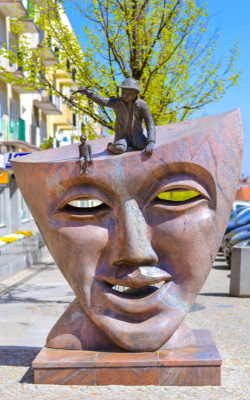








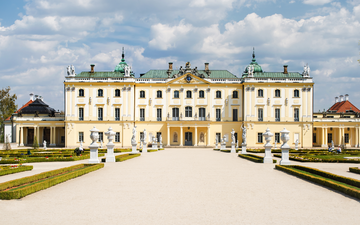
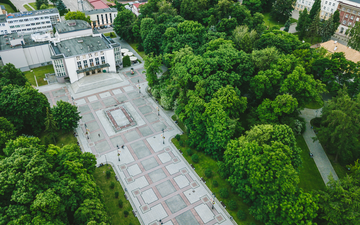
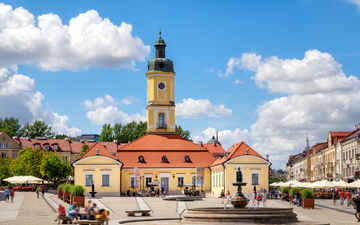
With the population of nearly 300,000, Bialystok is the largest city in the north-east part of Poland and is the capital city of Podlaskie voivodeship. It acts as an administrative, economic, scientific, and cultural centre of this part of the country, known as the “Green Lungs” of Poland due to its unique ecological values.
The location of the city in a clean region that is full of tourist attractions as well as the rich infrastructure make Bialystok and its surroundings a place which is attractive in terms of living and relaxing, as well as a touristic destination.
For centuries, the city’s inhabitants have formed a lively mosaic of religions and languages. Like nowhere else in the world, the domes of Orthodox churches harmoniously co-exist with Roman Catholic church spires. Living next to one another, Poles, Ruthenians, Jews, Tartars and the Romani peoples provided inspiration for Ludwik Zamenhof, the inventor of the universal language Esperanto.
The Branicki Palace, one of the most stunning Baroque residences in Central Europe, is considered the gem of the town’s historical heritage. This is actually one of the most beautiful palaces you can find in Poland, often called “Polish Versailles”. The gardens which surround the palace are among the best-preserved garden complexes in Poland.
Now houses a medical university and two museums.
The market square’s location in the heart of the city makes it a must-visit. The market is located close to the town hall, which was destroyed during the Second World War but later rebuilt in the 1950s. With the reconstruction, the town hall no longer served as a marketplace but was transformed into a museum and an art gallery. If you’d like to have a taste of authentic Polish food while holidaying in Bialystok, the market square never disappoints. Rynek Kosciuszki is surrounded by many authentic traditional restaurants.
For souvenirs, you’ll find many stores around the market square selling handmade souvenirs. The wide-open spaces at the square make it a beautiful place to relax, enjoy the fresh air, and play with the pigeons if you’re up to the task.
Białystok’s main artery begins at Kościuszko Market Square and continues west for 800 metres. Józef Piłsudski, Adolf Hitler and Josef Stalin have all had their names attached to Ulica Lipowa, before it returned to its original name (Lime Street) in the 1990s. More than any other street in the city, Ulica Lipowa bore the brunt of the German attack in the Second World War. But its high tenement houses and villas have been restored and there’s an array of interesting sights, like the Cristal Hotel, the first new hotel in Poland after the Second World War. If you cut down Ulica Malmeda you’ll come to a statue of L. L. Zamenhof, the Białystok-born doctor who invented Esperanto.
Get your cameras or phones charged and ready and pop on some comfortable footwear before embarking on a street art-finding mission because there are some seriously impressive works dotted around the city. Most notably, perhaps, is Polish artist Natalia Rak's Girl with a Watering Can. The enormous, vibrant, and utterly charming mural of the red-headed girl in traditional Polish dress watering a tree adorns the wall of the Chemistry Institute at the University of Białystok and is just begging to be posted on social media. Other noteworthy murals are all related to themes of history, nature, tolerance, and multiculturalism, some of which feature Henryk Sienkiewicz, Rev. Michał Sopoćko, and Ludwik Zamenhof, among others. There are almost 40 of these murals to enjoy, so if street art is your thing, be sure to allow yourself sufficient time.
BIALYSTOK TEMPLES
Bialystok is a city where, for centuries, next to the towers of Catholic Churches, the dimes of Orthodox churches have soared towards the sky. The multi-denominational character of the local community results from the history of these lands. Settlers from Mazovia were arriving from the west, and Ruthenians - followers of the Eastern Christianity - were coming to the Podlasie forests from the opposite side. With the passage of time, protestants and followers of other religions - Islam and Judaism - also came. Their descendants lived together for hundreds of years, creating a harmonious multicultural, colourful community. Today, this kind of mosaic of cultures constitutes a strong magnet attracting many tourists to the capital of Podlasie.
The oldest temple in Bialystok is the church founded by Piotr Wiesiołowski on today’s cathedral hill. The ‘White Church’ flourished during Branicki times. Today, it is an integral part of the metropolitan cathedral complex and at first glance it is hidden in the shadow of the huge body of the “red church". The monumental archcathedral was constructed of a typical Gothic Revival building material - red brick. The facade facing John Paul II square is dominated by two huge towers. Despite their height, they seem to be lightly raising towards the sky. Attention is drawn to three ogival portals of the front entrance with carvings in tympanums depicting Christ carrying the cross, crucifixion and resurrection. The temple was built on a layout of a Latin cross. Between the main nave and the two aisles there are rows of large pillars that support the cross-rib vaults. Large ogival windows and the rosette above the entrance are fitted with stained glass.
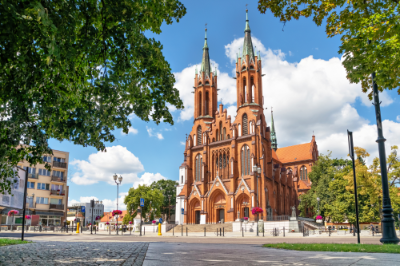
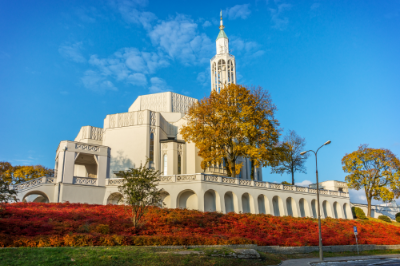
It is undoubtedly one of the most beautiful examples of a modernist sacred building in Europe. Not everyone, however, knows that in Bialystok many other buildings can be found that may generate interest, or even enchant the admirers of the twentieth-century trends in architecture. The earliest modernist buildings appeared in Bialystok even before the outbreak of World War I, but the most impressive structures were erected in the interwar period. St. Roch’s Church was erected as a monument – a thankful votive for Poland regaining independence and winning the war against the Bolsheviks. While looking at St. Roch’s Church, it is worth remembering that Sosnowski’s project is imbued with deep, symbolic content. The architectural and artistic reflection of the idea of the morning star is both the spatial arrangement of the building and the recurring star-crystal theme of decorations.
Is considered one of the most beautiful Orthodox churches in Poland. This is the largest Orthodox temple in our country and one of the largest in Europe. The architecture of the temple is full of deep symbolism. The forms of domes and elevations (filled with semicircular arches and ogives in the so-called donkey ridge) are supposed to suggest the flames of fire descending upon the apostles during the Pentecost. Five domes, in the tradition of Eastern religious architecture, symbolize Christ with four Evangelists. The interior of the temple also arouses the visitors’ admiration. The nave laid out on an octagon layout has an area of 800 square meters. The interior of the temple is filled with frescoes created at the beginning of the 21st century. Their authors were iconographers from Donetsk. In a huge dome, attention is drawn by ‘panikadilo’ - a chandelier reminiscent of a crown, with stained glass images of saints and apostles. It was created in Minsk, has a diameter of 6 m and weighs 1200 kg. This is the only such object in the world.
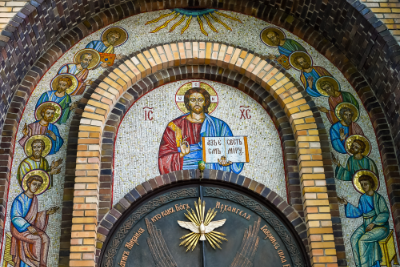
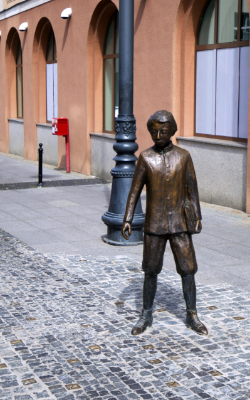
The Bialystok Puppet Theater is the first dedicated space specifically built for puppetry performances in Poland. They host many national and international puppetry festivals and events throughout the year and have regular premieres for adults and children. There is usually a mix of literary adaptations for adults and puppet shows more focused on fairy tales for children. You can even tour the Puppets Cellar which is a display area of memorabilia and costumes from past performances beneath the main stage of the Bialystok Puppet Theater.
